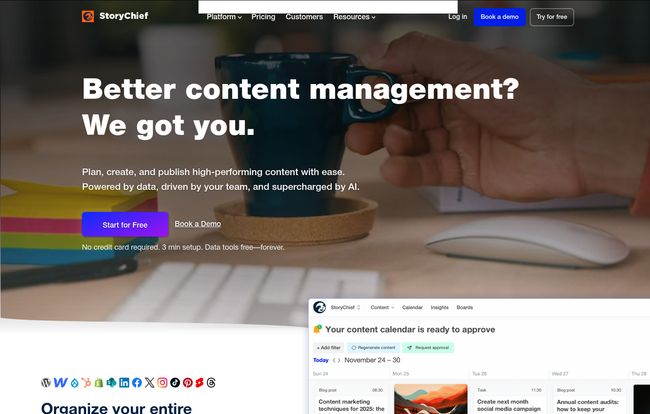If your content marketing workflow looks anything like mine used to, it’s probably a chaotic mix of Google Docs, Trello boards, a separate social media scheduler, Slack threads that disappear into the void, and about seven different analytics dashboards. It's a digital juggling act, and frankly, it’s exhausting. You spend more time managing the process than actually creating and promoting killer content.
I’ve been in the SEO and content game for years, and I’m always on the lookout for something, anything, that can bring a little sanity to the madness. So when I started hearing the buzz about StoryChief, a platform that claims to be an all-in-one hub for content teams, my curiosity was definitely piqued. They talk a big game about AI-powered strategy, seamless collaboration, and multi-channel distribution. But does it actually deliver? I decided to take a look under the hood.

Visit StoryChief
So, What Exactly Is StoryChief?
Think of StoryChief as the central command center for your entire content operation. It’s not just another text editor or a social media scheduler. It’s designed to be the single place where your team plans, writes, reviews, approves, publishes, and analyzes content. From a blog post that needs to go live on your WordPress site to the LinkedIn and TikTok posts that promote it, the goal is to manage it all without ever leaving the platform.
It’s built for teams—agencies managing a dozen clients, in-house marketing departments trying to stay aligned, you name it. The whole idea is to stop the endless copy-pasting and tab-switching and replace it with a single, coherent workflow. A pretty ambitious goal, if you ask me.
The Features That Actually Make a Difference
A platform is only as good as its features, right? Here’s where I think StoryChief really shines, and a few areas where the paint is still a little fresh.
Your Content Calendar on Steroids
First off, the Content Calendar is clean and comprehensive. It’s not just a list of dates. You can see everything at a glance—blog articles, social campaigns, newsletters—all color-coded and organized. You can filter by campaign, status (e.g., 'Writing', 'Awaiting Approval'), or team member. For a manager trying to get a high-level overview, this is gold. No more asking, “Hey, what’s the status of that blog post?” You just look at the calendar.
Multi-Channel Publishing Without the Headache
This, for me, is a massive selling point. StoryChief boasts hundreds of integrations. You write an article once, and with a few clicks, you can push it to your WordPress site, Webflow, Ghost, Medium, and even as a press release. Then, you can immediately create and schedule the social media promotion for LinkedIn, Facebook, Instagram, TikTok, and Pinterest to go along with it. The time savings here are no joke. It turns a 30-minute distribution task into a 3-minute one.
Let's Talk About William, the AI Marketing Agent
Okay, this is the futuristic stuff. StoryChief has its own AI assistant named “William.” He’s not here to write your entire article for you (thankfully), but to act as a co-pilot. William can help you generate content ideas, create strategic briefs, come up with headlines, and provide SEO suggestions right inside the editor. It also helps with translation and summarizing content for social media. It’s like having a junior strategist on call 24/7. While the AI is still relatively new and learning, it's a powerful way to break through writer's block and ensure your content is aligned with a solid strategy from the get-go.
SEO Copywriting and Content Audits on Autopilot
As an SEO guy, I'm naturally skeptical of built-in SEO tools. But StoryChief's is pretty solid. As you write, it gives you a real-time SEO score based on factors like keyword density, readability, meta descriptions, and internal linking. It's not going to replace Ahrefs or Semrush, but for on-page optimization, it’s incredibly handy. Even better is the Automated Content Audit. It scans your existing content and flags articles that are underperforming, have dropping traffic, or have technical issues. It’s a proactive way to find content decay and identify opportunities for a quick refresh.
Who Is StoryChief Really Built For?
This isn't a one-size-fits-all tool. I see it working best for a few specific groups:
- Content Marketing Teams: For any team with two or more people, having a central hub for collaboration, approvals, and scheduling is a game-changer. It eliminates the "who has the final version?" problem forever.
- SEO & Marketing Agencies: The ability to create separate workspaces for each client is huge. You can manage multiple clients from one dashboard, give them their own approval access, and keep everything tidy. The Agency plan is clearly designed with this in mind.
- Growing Small Businesses: If you're a solopreneur, the free plan is a great way to get your feet wet with analytics. Once you start hiring or working with freelancers, the Small Business plan becomes a very logical next step to formalize your content workflow.
The Big Question: StoryChief Pricing
Alright, let's talk money. Pricing can be a dealbreaker, so how does StoryChief stack up? They offer a few tiers, which I appreciate. (Prices are as of my last check, billed annually).
There's a Free plan that's genuinely useful, giving you free analytics on SEO and social media performance. It’s a great starting point. The Small Business plan starts at €49 per month and gets you one workspace, four social channels, and unlimited posts, which is a pretty sweet deal for a small team. For agencies, the Agency plan starts at €99 per month per client, offering unlimited users and channels per client, plus bulk discounts. And of course, there's a custom Enterprise plan if you're a big-league player needing SSO and a dedicated account manager. I've always felt that investing in a tool that saves you hours every week provides a clear return on investment, and StoryChief's pricing seems to fall right into that sweet spot for teams and agencies.
My Honest Take: The Good and The Not-So-Good
No tool is perfect. After spending some time with it, here’s my straightforward opinion.
The best things about StoryChief are its all-in-one nature and the multi-channel distribution. Not having to log in to five different platforms to publish and promote a single piece of content is a legitimate relief. The AI assistant, William, is more than a gimmick; it’s a genuinely useful brainstorming and strategy partner. The collaboration features are also top-notch.
On the flip side, the pricing, while fair for teams, might be a bit steep for a solo blogger or a brand new startup just finding its feet. And like any powerful platform, there is a learning curve. You’ll need to invest some time upfront to set up your integrations and workflows to really get the most out of it. It's not a plug-and-play solution, but the most powerful tools rarely are.
Is StoryChief the Answer to Your Content Chaos?
So, what's the verdict? If you're a solo creator who publishes infrequently, StoryChief might be overkill. But if you're part of a team, an agency, or a business that's serious about scaling its content marketing, it is absolutely worth a serious look. It's one of the few tools I've seen that successfully bridges the gap between content creation, project management, and distribution.
It’s not a magic wand that will instantly fix a broken content strategy, but it is a powerful platform that clears away the administrative clutter, allowing you to focus on what actually matters: creating content that connects with your audience and drives results.
Frequently Asked Questions
What is StoryChief best for?
StoryChief excels for content marketing teams and agencies that need to manage a complex workflow of creating, approving, and distributing content across multiple channels. Its strength is in centralization and collaboration.
Does StoryChief integrate with HubSpot and Webflow?
Yes! It has deep integrations with HubSpot, Webflow, WordPress, and hundreds of other platforms, including major social media networks, email marketing tools, and other CMS platforms.
Is the AI Marketing Agent, William, actually useful?
In my experience, yes. It's not going to write an award-winning article for you, but it's fantastic for generating ideas, creating content briefs, checking SEO, and repurposing your content for different channels. Think of it as a very capable assistant.
Can I try StoryChief before I buy?
Absolutely. They offer a free plan with basic analytics, and the paid plans come with a free trial so you can test out the full suite of features and see if it fits your team’s workflow.
Is it easy to add my whole team?
Yes, the platform is designed for collaboration. You can invite team members, freelancers, and even clients and assign them different roles and permissions, from writer to editor to approver.



